September Desert Gardening

September has arrived, and the Arizona garden feels the effects of a long, hot summer. Some plants are dead and crispy, peppers and tomatoes need pruning, the irrigation system could use a tune-up, and fallen branches from monsoon storms need clearing. The next planting season is just around the corner, so it’s time to get to work.
In this article, you’ll find the essential tasks to help your September vegetable, landscape, flower, and fruit garden transition to the next season. We’ll also discuss common pests to watch out for and give guidelines for watering during this pivotal month.
For specific details on what to plant and harvest in Arizona’s low desert during September, check out my planting guides or the blog post, “September Planting Guide for Arizona’s Low Desert.” The low desert includes areas below 3,500 feet in elevation, such as the Phoenix and Tucson metro regions.
Click on the title to jump to that section and learn more about what to do during September:
- Vegetable Gardening
- My September Garden Journals
- Pests & Wildlife to Watch Out For This Month
- Container Gardening Tasks
- Flower Gardening Tasks
- Caring for Roses During September
- Herb Gardening
- Fruit Trees and Citrus
- Landscape Plants
- September Watering Guidelines
More September YouTube Videos
Vegetable Gardening
Assess your Current Garden
If your garden has been struggling or hasn’t thrived as you’d hoped, it’s time to dig a little deeper—literally and figuratively. Start by evaluating the root causes and then do your best to fix them.
- Is your garden getting watered correctly? Is your soil too dry or too wet? Dig into your beds and check. Adjust watering if needed.
- Are tree roots from neighboring trees invading the space? Dig down and remove roots inside the bed, and find the incoming roots outside the bed. Pull back the roots and cut back as far as possible outside of the bed.
- How is your soil? It should be light and friable. The success of your raised bed garden largely depends on the quality of your soil. The top 12″ (30 cm) of your raised beds should be a high-quality raised bed mix. I use the raised bed mix from Arizona Worm Farm. You can make your own mix by combining compost, coconut coir, and vermiculite, or perlite. This mix ensures good drainage, moisture retention, and nutrient availability, providing an optimal environment for your vegetables to thrive. Learn more in this blog post.
- You might also consider testing your soil. Based on the results, amend the soil accordingly. I use and recommend this soil testing kit.

Plan Your Fall Garden
- Make a plan for fall and winter planting. Incorporate different vegetables, herbs, fruits, and flowers into your garden plan. This article explains how to plan your garden.
- Read “How to start a garden in 8 simple steps” to get started on your garden if you are a first-timer or are looking for a few tips.
Prepare Beds For Fall Planting
Throughout the season, organic matter decomposes, and the soil level in your raised beds will naturally drop and need replenishing. Pull back the mulch and top the soil with worm castings and a fresh layer of compost. If needed, add a raised bed mix to bring the soil level back up.
If you aren’t planting until October, plant a last round of cover crops – black-eyed peas or buckwheat— later in the month. The plants don’t have to get very large before they are chopped and used as organic matter to feed the soil. Learn more about using cover crops in this article.
Have irrigation in place for garden beds and planting areas. Check existing irrigation for leaks and make sure it is working correctly. If you use garden grids from Garden in Minutes, check that the holes are not clogged from hard water buildup. If they are, use a push pin to reopen closed holes.
Garden Tasks During September
- If your garden is anything like mine, it’s probably a mess, and it’s time to clean it up! Remove dead or dying plants. If they are diseased or infected with pests, throw them away in the trash, not your compost. Clean up debris in the garden. This can harbor pests and diseases.
- If you haven’t already and your plants are overgrown, cut back peppers, eggplants, and tomatoes to the newest leaves. This rejuvenates the plants for an excellent fall crop. After cutting back, top plants with worm castings and compost.
- Worms tend to make themselves scarce when the soil is hot. As temperatures cool, they will come back into your bins. Once nighttime temperatures are consistently below 80°F (26°C), it’s time to refresh in-bed vermicomposting bins or start new bins. Learn how in this blog post.
- Start seeds indoors for your favorite cool-season crops. This blog post details which seeds to start this month.
- Find seed potatoes and begin “chitting” them so they will be ready to plant later this month or in October. Learn more about how to grow potatoes in this article.
- This is the last chance to order garlic so you can plant it in October. Store it in the fridge until planting time.
- Pot any indoor-grown seedlings outgrowing their containers if it is not time to plant them outside. Fertilize indoor-grown seedlings every other watering.
- Keep up with daily okra harvests this month. Learn my seven favorite ways to use okra in this blog post.
- Roselle harvests begin in earnest this month. Learn more about growing roselle in this article.
- Once daytime temperatures are consistently below 90℉ (32°C), remove the shade cloth (if using).
- Cover newly planted seeds and seedlings with tulle to keep the birds from digging up seeds or eating seedlings.
- Turn and spray down your compost. It’s probably dried out over the summer. Add more greens if needed to heat it back up. Learn more about composting here.

Planting Cool Season Crops in September
Pay close attention to the weather this month. If temperatures are still in the 100s and the nights are still hot, wait to plant cool-season crops. If the soil temperatures are at or above 85°F, the soil is still very warm—wait to plant. Read this post for more information about how to measure your soil temperature.
For specific details on what to plant during September, check out my planting guides or the ‘September Planting Guide.’
My September Garden Journals

Twice a month, I send my personal garden journal to members of “Growing in the Garden Academy.” From the first seedling to the last harvest, you can follow my gardening adventures in Arizona’s unique low desert. As a member, you can access the past three years of garden journals and monthly classes.
Join me, and let’s make your garden thrive under the desert sun!
Low Desert Arizona in September: Pests & Wildlife to Watch Out For This Month
Unfortunately, the slightly cooler temperatures of September are inviting for pests.
- At this time of year, Tecoma plants, yellow bells, and bougainvillea may be infested with caterpillars. If the plant is large, it usually survives the infestation without affecting the tree’s overall health. If you decide to treat, you have a few choices: spray off with water or use BT. When the weather cools a bit, the caterpillars will have moved on. Prune off severely infected branches.
- Whiteflies are active in the warm weather of late summer and early fall. To keep infestations down, apply a soapy water solution of 1 Tablespoon Dawn to one gallon of water to the undersides of leaves daily.
- Grasshoppers are common this month. Handpick. Hopefully, the birds help you out, too.
- Spider mites can be problematic this month. Read this post for treatment options.
- Squash and Eastern Bordered Plant Bugs. This article shares prevention and treatment options.
- If rollie-pollies are eating seedlings (they love beans!), sprinkle a small amount of this slug and snail bait when you plant. Learn more in this blog post.
Beneficial insects and other wildlife in the garden during September:
Bees, assassin bugs, wasps, cicadas, hummingbirds, praying mantids, lizards, and butterflies like Swallowtails and Gulf Fritillary.

Container Gardening Tasks
It’s generally best to start over with fresh raised bed mix or another high-quality potting mix in containers. You can add spent container soil to fill empty garden beds, use it as mulch for trees, or add it to your compost.
However, it is possible to replenish and reinvigorate the soil used in your containers. This blog post explains how to do it.
To refresh large containers, pull back the mulch and remove large roots. Moisten the soil and check for drainage. Fill the remaining room with new raised bed mix. Add in a balanced organic fertilizer.
Arizona September Garden Tasks: Flower Gardening
September is a time of change in the annual flower bed. By the end of the month, you’ll want to clear out summer blooming annuals. Amend beds well with about an inch of compost (not more). If the soil is too rich, you’ll have many leaves but no flowers.
Once daytime temperatures consistently fall below 100℉ (38°C) and nights cool down below 80°F (27°C), plant cool-season annuals from seed and transplants. Water newly planted annuals each day until they show new growth and are established.
- October is a key planting month for wildflowers and winter flowers; you want to be ready. Order seeds, bulbs and corms and start winter flower seeds indoors.
- Collect seeds from blooming four o’clock flowers this month. Learn how to grow four o’clock flowers in this article. Save seeds from zinnias, sunset cosmos, and other summer flowers.
- Make a quick note of flowers that performed well for you this summer. Note when and where you planted them. Learn from your successes each year!

Arizona Annual Flowers Planting Calendar helps you learn when to plant flowers in Arizona and when to start seeds indoors.
Caring for Roses During September in Arizona
- Begin lightly fertilizing roses again this month. Keep up with watering every few days until temperatures cool in October.
- Once nighttime temperatures are in the 70s (21-26°C), prune roses lightly to remove dead or diseased canes. (This might be in October)
- Evaluate your roses. They may look haggard, but if plants are severely burned or struggling, consider moving them to a shadier location next month.
Make plans for planting roses next month. Choosing the right varieties helps ensure your roses survive the summer heat. Roses such as Memorial Day, Iceberg, Mother of Pearl, and Julia Child are excellent choices as they are known for their resilience and ability to withstand high temperatures.
I get all of my roses from Heirloom Roses. I love that they are own-root roses (no grafts!) and have the highest standards for diseases. You know you are getting robust, disease-free roses with strong roots when you get them from Heirloom Roses. Use Code GARDENAZ20 for 20% off any rose order through December 31, 2025. Order now and have them shipped when you are ready to plant (up to 8 months later).

Fruit and Fruit Trees
Poor summer watering practices cause citrus rinds to thicken, and they split when the fruit expands in the fall. Sun-damaged fruit is also common. Pick and discard any split or sun-damaged fruit this month. Do your best to provide regular deep watering for these fruit trees.
Many varieties of pomegranates will be ready to harvest in October or November. Remove fallen and infested fruit to keep leaf-footed bugs under control.
Apply the last round of citrus fertilizer early in the month—water well the day before and again after fertilizing. Skip fertilizing grapefruit this time; they require less fertilizer than other types of citrus trees. If you’re using the worm casting, compost, and mulch method, doing this on all trees is fine.
The best time to plant strawberries is in mid-September. Planting in warm soil allows the roots to become established. Learn more about how to grow strawberries in this blog post.

Lemons begin to ripen in September. Skin color is not always an indicator of ripeness, so taste the fruit to see when it is ready. Fruit stores best on the tree. The longer the fruit stays on the tree, the sweeter the fruit becomes. Fruit will not ripen once picked. Ripe citrus fruit can be left on the tree for up to 6 months, depending on the variety.
Herb Gardening

- Oregano, mint, and other perennial herbs look haggard. Once temperatures dip below 100℉ (37°C), trim them back by about 1/3, feed them with organic fertilizer, and water them well. This article explains more about growing perennial herbs.
- Continue harvesting to prevent the basil from going to seed. This recipe uses fresh basil in one of my favorite ways. This article shares how to grow basil.
- Garlic chive blooms are a sure indicator that it is September. The pollinators love the blooms. Learn more about growing garlic chives in this article.
The Arizona Herb Planting Guide helps you learn when to plant over 30 herbs in Arizona and whether to plant seeds or transplants.
Landscape Tasks in September
Planting:
September is a good time to plant agave, cactus, and yuccas. But October is the best time to plant most other landscape plants. If you can wait until then, there will be a larger selection, and many places (like the Desert Botanical Garden) have plant sales.
While waiting to plant, look around your neighborhood for plants you like that survived the summer. Use a plant ID app to identify them. Those plants might be good choices to replace dead plants in your yard. Try to plant them in the same exposure. Note the mature size of the plant and allow enough room.

Other landscape tasks:
- For existing plants, once you see new growth and temperatures below 100℉ (37°C), you can begin to cut back some perennials and vines.
- Amend perennials with compost.
- Hose off plants prone to spider mites about once a week.
- Pull weeds that emerge after monsoon rains. Do not let them set seed.
Arizona Garden in September Watering Guidelines
Think about ways to harvest or channel rainfall and direct it on your property. Read this post to learn more about using rainwater harvesting and swales and berms to collect and use rainwater.
Watering Containers During September
I usually water my containers every 3-4 days in September and fill up the ollas each time I water. I use ollas from Growoya.
Watering Annuals and Garden Beds During September
As nighttime temperatures decline, gradually lengthen the time between watering. Water to a depth of about 8-12 inches every 2-5 days, allowing the top of the soil to dry out before watering again. I usually water my raised beds every 3-4 days in September. I use the garden grids from Garden in Minutes to water them. (Use code Angela10 to save $10 off $100 or GITG5 to save 5 percent on any size order.)
Tree and Vine Watering Guidelines: 1, 2
When daytime temperatures are below 100℉ (37°C), begin to adjust the time between watering citrus and other fruit trees to around twice a month. Do this gradually by adding 1-2 days onto the watering frequency until your trees are being watered twice a month.
- Established citrus trees should be watered once every 7-14 days to a 2-3 feet depth.
- Water annual fruit and high water use vines every 2-5 days to a depth of 8-12″.
- Water established fruit trees every 7-10 days to a depth of 18-24″.
- Grape vines need deep watering every 5 days.
- Water annual fruit and high water use vines every 2-5 days to a depth of 8-12″.
- Desert-adapted trees, shrubs & vines every 7-21 days (water to a depth of 24-36″ trees / 18-24″ shrubs / 8-12″ vines).
- High water use trees every 7-10 days (water to a depth of 18-24″).
- High water use shrubs every 5-7 days (water to a depth of 8-12″).
Sources:
1 – For additional information on watering practices, visit: “Association of Municipal Water Users Authority. (2023). Landscaping with Style in the Arizona Desert.” https://www.amwua.org/landscaping-with-style.
2 – https://extension.arizona.edu/sites/extension.arizona.edu/files/pubs/az1151-2021%20%282%29.pdf


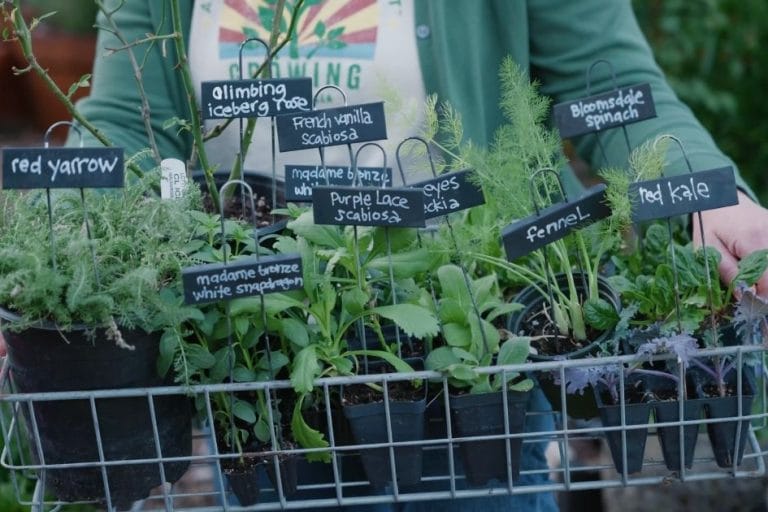
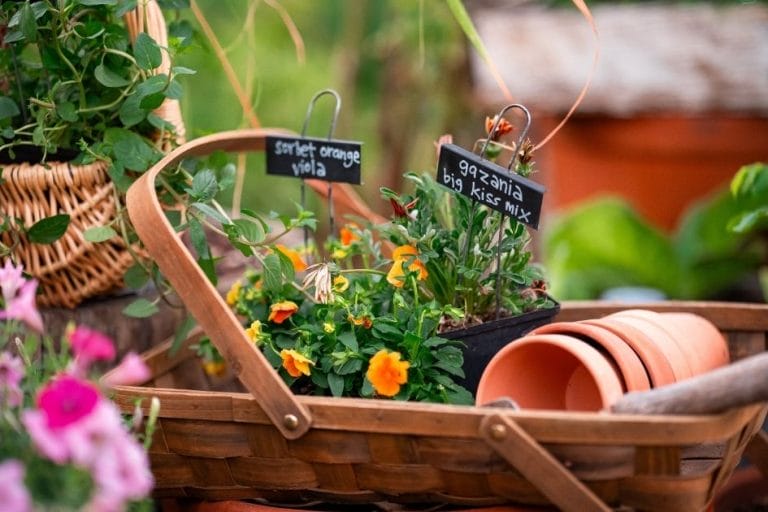

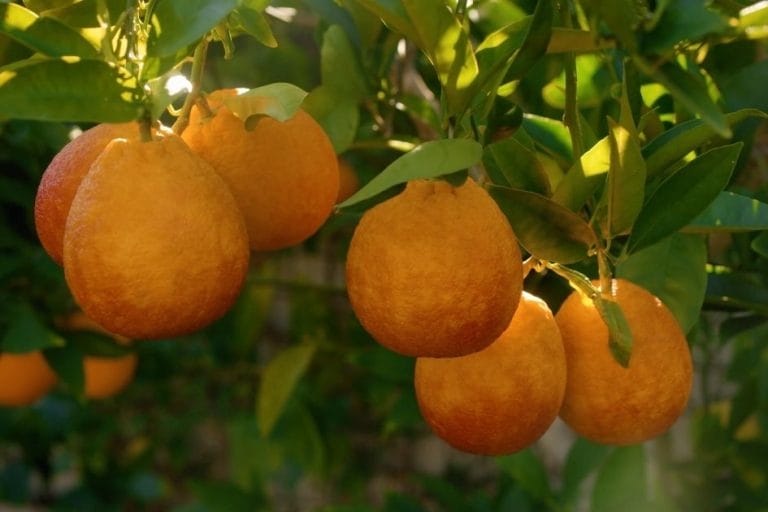
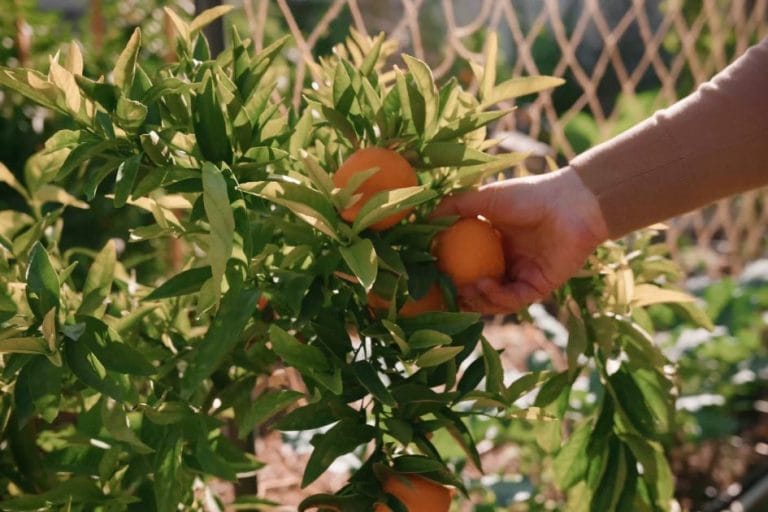
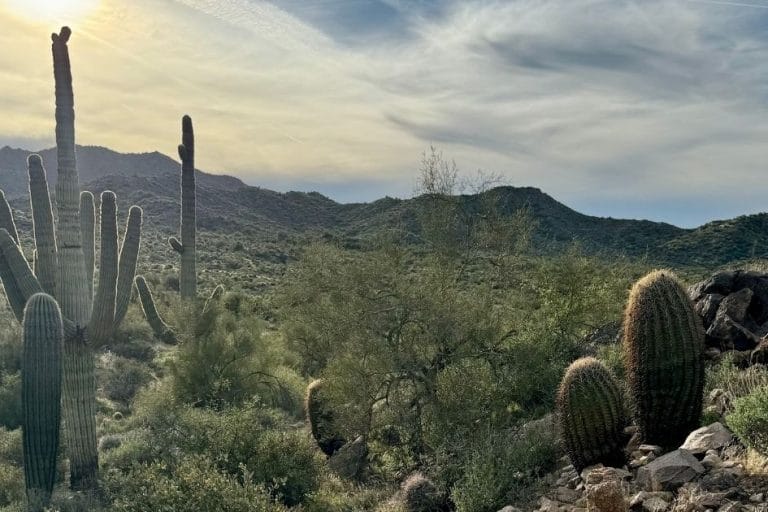
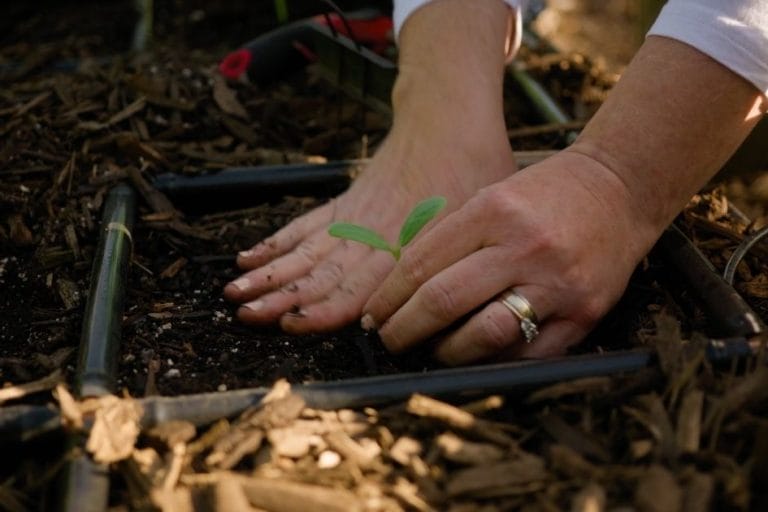
Love your blog, thank you so much!
When will you visit Yuma, AZ?? I have been successful in planting wildflower, vines, and hollyhocks, beans, beets, radishes, chards, from seeds outside. I really don’t like planting seeds inside as starters. My grandmother would always spread her seeds in her garden and let nature take care of it. I have not been successful with tomatoes, eggplants, artichokes, corn, some herbs or carrots.
Because our seasons are so short, transplants give us a head start. If you don’t want to start seeds indoors you can always look for transplants at local nurseries.